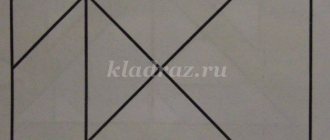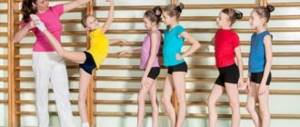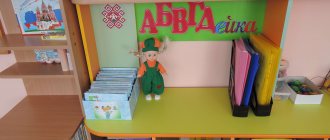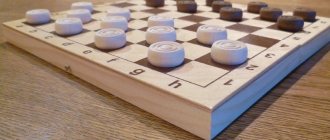Senior group. Senior preschool age. Children 5-6 years old
Summary of an open lesson on speech development “Come and visit a fairy tale.” Senior group “Fairy tale, come visit”
.
Open lesson on speech development in the senior group . Teacher of MBDOU "CRR - kindergarten No. 169"
Kuznetsova O.V.
Goal: development of all components of children's oral speech .
Program objectives: - consolidate knowledge about fairy tales; - consolidate the ability to select related... Summary of a lesson on speech development with elements of theatricalization for children of the senior group (V. Suteev “Under the Mushroom”) Summary of a lesson on speech development with elements of theatricalization for children of the senior group (dramatization of the fairy tale by V. Suteev “Under the Mushroom”
Goal: Creating favorable conditions for creative activity in children through theatrical activities. Forming children's interest in the game -...
Didactic games
Games with ready-made texts: didactic “I was born a gardener”, “Colors”, “Smeshinki”, etc. (master the variety of initiative and response remarks, become familiar with the implementation of the basic rules of dialogue).
Application of didactic game
Here are didactic games that involve dialogic interaction, but do not contain ready-made remarks: “Who will confuse whom”, “Order”, “Alike - not alike”, “Help yourself to a pie”, games with the phone “Calling a doctor”, “Calling mom at work” ", "Bureau of Good.
Didactic game “Tell me which one?” What is he doing?"
Purpose: to exercise in the formation of a sign from an object, for example, toy - toy, doll - doll, table - tabletop, winter - cold.
The use of mnemonics in the development of speech in preschool children
Didactic game “Name whose subject: mine, mine, mine?”
Goal: to consolidate knowledge about the subjects necessary for the work of a doctor. Enter words from medical terminology into the active dictionary.
Note! The guys must look at the objects and say what they are called. (Thermometer, syringe, cotton wool, bandage, phonendoscope, tablets, heating pad, brilliant green, tweezers, massager).
The teacher asks the children whether they know what profession the person who needs these items has? To the doctor. What does a doctor do? He treats, monitors the health of patients, gives vaccinations, massages, weighs, etc.)
Lesson summary on the topic “Migratory birds”
Posters with images of migratory birds
Additional Information . Be sure to create a good, fun environment in the group. Only then will the lesson be effective and easy for the child to understand.
Mathematics classes with children 3-4 years old at home and in kindergarten
Materials for open lesson:
- Pictures of migratory birds,
- Mnemotables,
- Sheets of paper,
- Gouache,
- Stamps,
- Hoops, balls,
- Medals "Friends of the Bird".
Lesson outline:
- Greetings and organizational details,
- Conversation about birds
- Gymnastics for fingers,
- Playing with a ball or hoop
- Working with mnemonic tables,
- Working with the material that is distributed during the lesson,
- Games and educational conversations,
- Consolidation of the result, questions for children.
Developmental programs
In order for classes to run smoothly, you need to carefully study the requirements of the Federal State Educational Standard and discuss their practical implementation in the lesson plan at the kindergarten methodological council
In accordance with the requirements of the Federal State Educational Standard and the specific tasks of an educational preschool institution, a methodological team of employees is developing a work program in all areas of education, including speech development. You can use the work of your colleagues as a basis, adding or correcting nuances regarding form and content (except for those moments that implement the tasks of the Federal State Educational Standard).
Fragment of the work program for 3 months
Author Anna Krivosheeva, https://nsportal.ru/detskiy-sad/razvitie-rechi/2014/01/31/rabochaya-programma-po-razvitiyu-rechi-v-starshey-gruppe.
| Month | Theme and objectives of the 1st week classes | Theme and objectives of the 2nd week classes | Theme and objectives of the 3rd week lessons | Theme and objectives of the 4th week of classes | |
| 1 | 2 | 3 | 4 | 5 | 6 |
| September | Subject | A story from experience on the topic “Our toys” | A story on the theme of E. Trutneva’s poem “Summer Flies Away” | Retelling of the story by N. Kalinina “Is this how they play” | Examination of I. Levitan’s painting “Birch Grove” |
| Goals | Teach: – describe the appearance of the toy; - talk about how you can play with her, what toys you have at home. Strengthen the ability to: – Clearly pronounce the sounds [s] and [z], isolate them from words, words with these sounds from phrases; – pronounce phrases loudly, quietly, in a whisper | Learn to write a short story based on a poem. Exercise in the formation of singular and plural forms of nouns denoting animals | Learn: – convey text expressively without omissions or repetition; – select verbs to nouns according to their meaning. Activate verbs in speech | Learn to talk about the content of a picture by observation. Practice using simple, compound and complex sentences. Strengthen the ability to form words with similar meanings | |
| October | Subject | Examination and storytelling based on the painting by I. Levitan “Golden Autumn” | Compiling a story from experience based on the plot picture “Family” | Retelling, V. Chaplin “Forest in Autumn” | Compiling a story from the experience “Grandma has a lot of trouble with us” |
| Goals | Learn: – make sentences with homogeneous members; – distribute proposals by introducing definitions, additions, and circumstances into them. Clarify and consolidate the correct pronunciation of the sounds [w], [z]. Learn to differentiate these sounds, pronounce words with them clearly and clearly, divide two-syllable words into parts, show the sequence of meaning of syllables in a word | Form ideas about the family by naming the names and patronymics of your parents. Clarify and consolidate the correct pronunciation of the sounds [s] and [ts], learn to differentiate these sounds by ear, and clearly pronounce words and phrases with these sounds. Foster love and respect for family members | Develop the ability to write a story. Practice selecting synonyms and antonyms, adjectives and adverbs in comparative degrees. Enrich your speech with nouns denoting plants. Foster love and respect for family members | Improve your ability to write a short story about your family members. Practice intonation expressiveness of speech. Learn to pronounce a phrase with different intonations (question, surprise, offense, dissatisfaction). Practice pronouncing pure tongue twisters and tongue twisters using the sounds [s], [ts], [sh], [sh'] at different tempos and voice strength | |
| November | Subject | Examination and description of I. Shishkin’s painting “Rye” | Role-playing game “Vegetables and fruits in the store” | Retelling of the fairy tale “The Fox and the Crayfish” | Compiling a story on the topic “Gifts of Nature” |
| Goals | Practice choosing synonyms and antonyms. Develop the ability to come up with endings to stories. Learn to use difficult forms of the genitive plural (boots, stockings, socks, slippers, mittens) | Learn to talk about objects. Introduce new professions. Practice the formation of cognate words. Clarify and consolidate the correct pronunciation of sounds [ш'], [ч'], learn to distinguish these sounds, highlight them in words | Teach: – tell a fairy tale coherently and consistently; – form words with similar meanings. Encourage writing a descriptive story “Fox” | Teach: – compose a short story on a given topic; – select words that sound similar; – highlight words with the sounds [h'], [h'] in phrases; – pronounce words with different voice strengths |
Class structure
All speech development classes in the senior group are conducted according to the same scheme
To achieve maximum results from each lesson, experienced methodologists have developed a structure for speech development classes. It is this combination of stages of work that is a “cure for boredom,” that is, it helps to maintain children’s interest and thereby achieve their goals.
- Involving the guys (about 5 minutes). Curiosity and playfulness are the main qualities of children, which adults need to “play” with. That is, an invitation to take part in a fairy tale will be attractive even to restless toddlers.
- Completing tasks (10 minutes). This is the main stage of training, which is carried out during the period of better concentration of children, that is, after the warm-up, the first stage.
- Pause (2 minutes). During the previous stage, the guys accumulated a lot of energy, which needs to be given the opportunity to come out. This could be a game, dance or physical exercise.
- Time for a story (10 minutes). Reading a fairy tale, a story (this can be a joint idea with the children), discussing and playing out the plot is not only work on speech development, but also an element of the formation of moral ideas in children.
- Final stage (about 3 minutes). Tasks of a different nature (reproductive, when you need to repeat some of the characters’ lines, for example, or creative - draw an illustration) will allow you to consolidate the acquired knowledge and practice skills.
Some activities are based entirely on a fairy tale. In this case, the timing of the penultimate stage is divided equally into the remaining ones.
Examples of plans
Effective ways to engage and set milestones
Oksana Shavkun, https://nsportal.ru/detskiy-sad/razvitie-rechi/2016/04/14/zanyatie-po-razvitiyu-rechi-v-starshey-gruppe
Subject: "Pets" Target:
Preliminary work:
Progress of the lesson Engagement There are 2 tables on the carpet. Guys, this morning they brought us a package from grandmother Ulyana and grandfather Fedya. They sent us their photo and letter. Listen to what they write: “Dear guys! We have a granddaughter Masha. But she went traveling and got lost in the fabulous land of Knowledge. Help us, please, we are already old and cannot find her. We hope that you are brave and active and can help us. Thank you very much. Grandfather Fedya and grandmother Ulyana." Guys! Shall we help grandparents? Then we go on a journey to the land of Knowledge. What do you think you can travel with? Children: by car, by bus, by bicycle, in a hot air balloon, etc. Teacher: you and I will go... No, try to guess for yourself. Riddle: The brothers got ready to visit, clung to each other, and rushed off on a long journey, only leaving a trail of smoke. (train) Teacher : Correct. This is a train. He has been waiting for you for a long time, but only those who purchase a ticket will board the carriage. And the ticket to our train will be a picture with a pet. (Children name the animals and sit down. The song “Blue Car” plays.) The chairs stand in the form of a carriage. Completing tasks Teacher : So, guys, we have arrived in the Land of Knowledge. This Country is unusual and mysterious. And the objects in this country are unusual. Look what a beautiful flower. Do you know what it's called? Children : flower - seven flowers Teacher : right, who knows why it is called that? Children : it has 7 petals of different colors. Name the colors of the petals. He will help us find Masha. But for this you need to open all the petals. Look, it has numbers on its petals. The same numbers are on the envelopes with assignments. We need to open all the envelopes, there should be 7 of them - the same number as the number of petals of a seven-flowered flower. We must complete all the tasks and then open the petals with the same numbers. And then Tsvetik - seven-colored will help us find Masha. Let `s start! Then look for 7 envelopes, bring them to the table and we will open them in order and complete the tasks. (children bring envelopes, find them with the number 1) Each child who brought the envelope must tell where the envelope was, using prepositions. We approach the easel. Grandmother and grandfather have many loyal friends in the village. They look after them, and their friends are not in debt. Want to see who it is? Speech game: “Which one, which one, which one?” Who is this? What is she like? And who is this? What is she like? Children take turns going to the magnetic board, taking a card, looking at it, showing it to all the children and talking about who is depicted on the card. This is a cow. She is big, red, with black spots, smart, milky, and horned. This is a dog. Small, brown, smart, fluffy, kind. (goat - small, white, horned, bearded, lively; cat - small, fluffy, affectionate, mustachioed, striped) One child describes, the rest add. Now we open the petal with the number 1. What is the next number after the number one? Find the envelope with the number 2...> |
Four stages of speech development classes
Marina Gotovkina, https://nsportal.ru/detskiy-sad/razvitie-rechi/2014/01/23/zanyatie-po-razvitiyu-rechi-v-starshey-gruppe
| Topic: “Composing a story based on a series of plot pictures “The Girl and the Hedgehog” Goal: Continue to develop the ability to solve riddles, justifying your answer. Continue to develop the ability to carefully examine a picture, highlight the main idea in it (with the help of the teacher’s questions) and voice it; compose a complete story based on plot pictures, using different types of sentences. Encourage children to come up with the ending of the story. Practice choosing words on a given topic. Develop perception, memory, attention. Develop the ability to listen to each other and not interrupt while performing a task; negotiate and come to a common opinion. Materials: story pictures, tokens, two baskets, two sets of elements of the last picture. Progress: Involvement Educator: Guys, today we will compose a story using pictures. And who and what the story will be about, you will tell yourself as soon as you guess the riddles. She has pigtails, long eyelashes, a skirt with flounces, a dress with pockets. Who is it: a squirrel, a boy or a girl? (Girl). How did you guess? While the children - Everyone is wearing a beret. They grew up and put on their hats. (Mushrooms). Why did you decide that it was mushrooms? What kind of Christmas tree is this? This is a living Christmas tree. In gray clothes, he walks along the path. (Hedgehog). Prove that it is a hedgehog. The hero stands rich, treats everyone in a row: Vanya with strawberries, Anya with stone fruits, Mashenka with a nut, Petya with russula, Katenka with raspberries, and Vasya with a twig. (Forest). Why did they decide that this was a forest? Prove it. Educator: So, who and what are we going to write a story about? Completing tasks The teacher shows the children the first picture. What is shown in this picture? Who is depicted? What is the girl doing? (holds an empty basket in his hands, talks to the hedgehog, probably asking something). The teacher shows the children the second picture. What is shown in this picture? (a forest, but a completely different place: there are a lot of mushrooms under the trees). What is the hedgehog doing? (he says something to the girl and points to the mushrooms and the basket). The teacher shows the last picture. What is shown in the last picture? (the girl picked up a full basket of mushrooms, leaves, waves her hand goodbye, the hedgehog remains in the forest). Educator: We looked carefully at all the pictures. Now you will compose a story from all the pictures from beginning to end at once, but try to each think of what the characters could say to each other goodbye and what could happen to them next (5-6 stories). Pause Teacher: Okay, now let’s warm up a little. You will be divided into two teams. Today you will choose words on the topic “Forest”. For each word, each team puts a token in its basket. The main condition: that the words are not repeated. At the end of the game we will count the tokens and find out which team knows more words on the topic “Forest”. Final stage Educator: I propose another interesting exercise. With its help, we can check what kind of memory you have, how attentive you are. Look carefully at the picture and try to remember where everything is located. (children watch for 15–20 seconds, the picture is removed). Now you must assemble a whole picture from individual parts, just like the artist did. (At the end of the task, the children count how many mistakes each team made). At the end of the lesson, a summary is made. |




